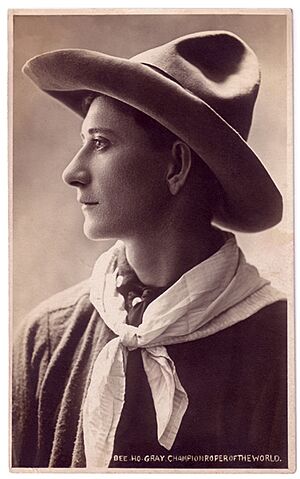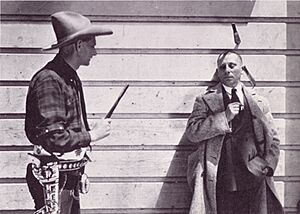Bee Ho Gray facts for kids
Bee Ho Gray (born Emberry Cannon Gray) was an amazing Western performer. He spent 50 years showing off his skills in many different types of shows. These included Wild West shows, vaudeville (a type of stage entertainment), circus, silent movies, and radio.
Bee Ho was best known for his incredible trick roping. But he was also great at knife throwing, using bullwhips, trick riding, and playing the banjo. He often combined all these talents into a funny act. Throughout his long career, people often compared him to the famous performer Will Rogers. This made sense, as Bee Ho and Will worked together many times and even developed their acts together in the early 1900s.
Contents
Who Was Bee Ho Gray?
Early Life and Name
Emberry Cannon Gray was born on April 7, 1885, in Leon, which was part of the Chickasaw Nation in Indian Territory (now Oklahoma). When he was very young, his family moved to a small town called Cache.
Bee Ho's mother was one-quarter Chickasaw. His father had been a Texas Ranger and later served in the Confederate Army.
Gray grew up around Apache, Comanche, and Kiowa people. Cache was a busy town for these Native American tribes. Bee Ho and his brothers played with the children of Comanche Chief Quanah Parker. His parents became good friends with the Parker family. By the time Emberry was five years old, Chief Quanah gave him the name "Bee Ho." This name meant "Brother of the Cripple" because Bee Ho's brother, Emmet Gray, had polio as a child and used a crutch.
Learning Western Skills
Bee Ho learned his Western skills on the wide-open lands of Indian Territory. However, he didn't see a real trick roper until around 1900. Bee Ho and his younger brother, Weaver, heard about the amazing tricks performed by ropers in Wild West shows.
They rode 60 miles on one horse to the town of Chickasha to see the Pawnee Bill Wild West exhibition. This trip took them two days! They were very impressed by the trick ropers. After that, they started teaching themselves rope tricks using clothesline and anything else they could spin. Within a few years, both brothers were performing in Wild West shows. Both Bee Ho and Weaver had amazing 50-year careers in Western entertainment.
Performing in Wild West Shows
First Big Performances
In his early career, Bee Ho performed with several Wild West shows. His first important shows were with Colonel Cummins' Wild West Indian Congress and Rough Riders of the World. This was at the 1904 Louisiana Purchase Exposition, also known as the Saint Louis World's Fair. Other famous performers there included Geronimo, Will Rogers, and well-known Native American chiefs.
Joining the 101 Ranch Show
In 1907, Bee Ho joined the Miller Brothers 101 Ranch Real Wild West show. This was its first year touring the United States. Many famous people performed with the 101 Ranch, such as Tom Mix, Ken Maynard, Hoot Gibson, Buck Jones, and Buffalo Bill Cody.
Even though Will Rogers was never officially hired by the 101 Ranch, he visited often. He spent a lot of time with friends there and took part in informal roping contests. Bee Ho and his wife, Ada Sommerville, traveled with the 101 Ranch for most of the years between 1907 and 1916. Ada was a Broadway actress, horse rider, and horse trainer. They sometimes left to perform with other shows or compete in early rodeos. The Miller Brothers 101 Ranch Real Wild West toured from 1907–1916 and again from 1925-1931.
Bee Ho also performed with many other shows. These included California Frank's All-Star Wild West, Irwin Brothers Cheyenne Frontier Days Wild West Show, Diamond Dick's Wild West, Barnum and Bailey Circus, and Ringling Brothers Circus. He even had his own show, Bee Ho Gray's Wild West.
Working with Native American Chiefs
Growing up in Indian Territory, Bee Ho learned the sign language and spoken language of different Native American tribes. Around 1912, Bee Ho went with Sioux Chief Iron Tail to Washington, D.C., and New York. Iron Tail was posing for sculptor James Earle Fraser. Fraser was working on designs for the new buffalo nickel. Bee Ho and Iron Tail had worked together in Wild West shows before this. Bee Ho traveled with Iron Tail to help as an interpreter and guide.
World Champion Roper
Bee Ho won the World Champion Trick and Fancy Roper title at Guy Weadick's Winnipeg Stampede in 1913. He showed off a rope trick that no one had ever seen before. This trick was called the "Three-Rope Catch." It involved catching a galloping horse and rider with three ropes at the same time:
- One rope went around the rider's body.
- Another rope went around the horse's neck.
- The third rope went around all four of the horse's legs.
Bee Ho won the title from Tex McLeod and held it until 1916. He was the only person who could do this trick for several years. He later taught it to Will Rogers. Will performed it in his 1922 silent movie The Ropin' Fool. Bee Ho won the championship again in the early 1920s at the Cheyenne Frontier Days and Pendleton Round-Up rodeos.
By the mid-1920s, Bee Ho Gray stopped competing in roping. He wanted to focus more on his vaudeville and film career.
Vaudeville and Film Career
Bee Ho and Ada spent many years performing in vaudeville shows. They traveled with the B. F. Keith, Orpheum, and Western theater circuits. Their show was a mix of funny conversations and amazing tricks. They performed complex rope tricks, knife throwing, whip cracking, banjo playing, and even horse dancing. Their show was very popular and often received top billing. The couple traveled to Europe several times to perform. They had a very busy schedule and performed in thousands of shows throughout their careers.
Movies and Radio
Bee Ho performed in Erich von Stroheim's movie Greed in 1924. Most of his performance was cut from the movie when it was made much shorter. However, his name is still listed as an actor in the film. One of his amazing skills still appears in the movie. During an argument between two characters, a knife is thrown and sticks into the wall right next to an actor's face. This was Bee Ho Gray's knife throwing skill!
Bee Ho also appeared in several other early Western movies. These included films from Miller Brothers 101 Ranch Bison Films, Monogram Pictures, and the Vitaphone Corporation, like Hey! Hey! Westerner.
In May and June 1922, Bee Ho and Ada Sommerville were featured in a Broadway musical called Red Pepper. It played at the Shubert Theatre in New York City. The show then toured for a year, ending in North Dakota in June 1923.
In the early 1930s, Bee Ho added a trained coyote named "Chink" to his act. He also started appearing on the radio, sharing his witty Oklahoma comedy. He performed on stage and radio with famous people like Bing Crosby, Will Rogers, Fred Stone, and Tom Mix. Many Western stars from the early 1900s got their start with him at the Miller Brothers 101 Ranch Wild West show. This was a time when their way of life on the open range was changing.
Later Years
Ada Sommerville passed away in 1940 when she was 68 years old. Bee Ho continued his act with other assistants. However, the vaudeville era was ending. His career shifted to performing at county fairs, small company events, and school benefits.
During his career, Bee Ho performed for at least four United States presidents. He also performed for members of European royalty, diplomats, and many other important people. He passed away in Pueblo, Colorado, on August 3, 1951, at the age of 66. He was visiting his sister at the time. Many of his fans, friends, and family members didn't know what happened to him after he stopped performing widely.
Images for kids





